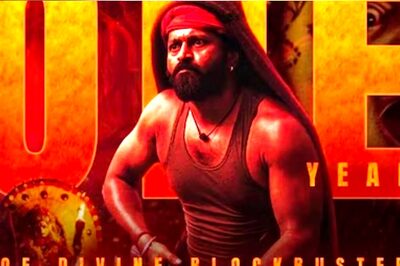
views
New Delhi: The exit polls on Friday handed Congress a convincing win in Rajasthan elections and predicted a close fight between the grand old party and the Bharatiya Janata Party (BJP) in Hindi Heartland states of Madhya Pradesh and Chattisgarh, regions considered a bastion of the BJP.
In Telangana, K Chandrashekar Rao-led Telangana Rashtra Samithi (TRS) appeared to have a clear majority, fighting off a challenge from the Congress and Telugu Desam Party (TDP) alliance. And Despite BJP's considerable gains in the North East, polls predicted an upper hand for the Mizo National Front's (MNF) in a two-way fight with Congress in Mizoram.
If the preliminary numbers and predictions are to be believed, the Assembly election results in the five states represent bad news for the saffron party, especially with the Lok Sabha elections looming large. For the Congress, on the other hand, a near-certain win in Rajasthan, coupled with a chance to overthrow Shivraj Singh Chouhan and Raman Singh in Madhya Pradesh and Chhattisgarh respectively, could signal their fortunes changing for the better.
These gains, however, have not come overnight. In addition to active politics, the Congress conducted focused digital campaigns and also released election manifestos based on suggestions from voters in Chhattisgarh and Rajasthan. This interactive effort, along with digital and social media campaigns targeting the BJP government, seems to have paid dividends.
"In Rajasthan, firstly, we did a completely people-oriented campaign called 'Rajasthan Ka Report Card' in which ground-based teams went across the state and got feedback from BJP constituencies over how their MLAs have fared," said Naresh Arora, political strategist and director of Design Boxed, a political digital campaign management company that worked closely with Congress for the state elections in Rajasthan and Chhattisgarh.
In the same campaign, the company also analysed BJP government's performance on issues and whether it had delivered on its promises. Two other campaigns, 'Vijayi Bhav Rajasthan’ and ‘Jhooth Par Chott, Sach Ko Vote’, were also conducted in Jhalawar, Chief Minister Vasundhara Raje's stronghold, to gauge public sentiment and to capitalise on anti-incumbency in the state.
The biggest impact, however, seems to have come from Congress' Janghoshna Patra or its election manifesto. "We received 2 lakh suggestions in a digital effort for the people's manifesto. People of Rajasthan sent us suggestions through videos, voice recordings, SMS. It was a massive success and helped us formulate the manifesto," said Arora, who worked with Pradesh Congress President Sachin Pilot for the campaigns.
These four major campaigns in Rajasthan helped create considerable online engagement for the Congress and helped the party get an early edge going into elections. The major issues the four campaigns targeted in the state were unemployment, loan waivers for farmers, Minimum Support Price for crops, healthcare and women's safety among others.
"This is probably the first time the BJP has been beaten in its own game," Arora said. BJP is known to employ targeted online campaigns to bolster its presence in the states. In fact, the party’s online presence is said to have been a big reason for its massive success in the 2013 Lok Sabha elections.
Raghu Sharma, Congress' election campaign committee chairman in the state and a candidate from Kekri seat, also said party's efforts to connect with the masses are set to translate into a mandate. "The high voter turnout indicates the people want change. Our entire manifesto was designed around people's suggestions and the issues that they were facing," Sharma told News18.com a day after exit poll numbers.
According to Arora, Congress got almost 10 million hits online and on social media in the last two months. "BJP has been found wanting and had no answers to the questions we raised with the help of public engagement," Arora said.
In Chhattisgarh, Arora worked with Harish Choudhary and manifesto committee chairman T.S. Singh Deo and handled digital election campaign. On November 9, the Congress launched its manifesto after a massive nine-month effort. "It was an extensive exercise, physically too. We met 1 lakh people personally over that time period. The manifesto in Chhattisgarh, too, was called the Janghosna Patra. It was made from the suggestions gathered and even listed the names of the people whose suggestions had been featured," Arora said.
Compared to Chhattisgarh, Arora had only one month to work on the campaigns and manifesto in Rajasthan. "There was too little time. We couldn't go physically to each area and talk to people like in Chhattisgarh, so the campaign in Rajasthan was more digitally focused," he said.
The process was kept simple, so that no section of society would be excluded. Anyone could call on a toll-free number and record a suggestion for the manifesto. "We even got Whatsapp videos, we aired some of them on the social media. The people felt happy. They felt like they were stakeholders," Arora said.
Design Box started out as a digital marketing and content creation company and jumped into handling digital political campaigns ahead of Punjab elections. "Since then, we have done campaigns in Punjab, Himachal Pradesh, Chhattisgarh and Rajasthan," Arora said.
Following BJP's success, political parties are now following suit and putting emphasis on digital campaigns. It is for the same reason that political strategists like Prashant Kishor, who currently works for Janata Dal United, are much sought after. Kishore had handled BJP's Lok Sabha campaign ahead of 2013 general elections and also had a stint with the Congress in Uttar Pradesh.
According to Arora, digital campaigns are gradually replacing the age-old methods of electioneering. Standing on a stage and asking for votes is quaint now. "It doesn't matter how many rallies you do. Engagement over rallies is a bygone thing. Now they are more a show of strength, about showing how much crowd you can gather. But everyone in this game knows those crowds don't come on their own," Arora said. "For social media, however, there is no incentive for anyone to engage. People see and they make up their own mind," he added.




















Comments
0 comment